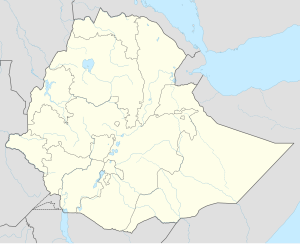Metemma(Amharic:መተማ), also known asMetemma Yohannes,is a town in northwesternEthiopia,on theborder with Sudan.Located in theSemien Gondar Zoneof theAmhara Region,Metemma has a latitude and longitude of12°58′N36°12′E/ 12.967°N 36.200°Ewith an elevation of 685 meters above sea level. Across the border is the corresponding Sudanese village ofGallabat.According to the British diplomatHormuzd Rassam,who travelled through Metemma in November 1865 on his diplomatic mission to EmperorTewodros II,"Metemma" comes from theArabicword for "the place of cutting, or termination – indicating the end of theMuslimprovinces ", although at the time the settlement was better known as Suk ul-Gallabat (" The market of Gallabat ").[1]
Metemma
መተማ | |
|---|---|
Town | |
| Coordinates:12°58′N36°12′E/ 12.967°N 36.200°E | |
| Country | |
| Region | Amhara Region |
| Zone | west Gondar Zone |
| Elevation | 685 m (2,247 ft) |
| Population (2005 est.) | |
• Total | 50,581 |
| Time zone | UTC+3(EAT) |
History
editThe town traces its origins to the 18th century, when a colony ofTukrirfromDarfurfinding the spot a convenient resting-place for their fellow-pilgrims on their way to Mecca and back, obtained permission from the Emperor of Ethiopia to make a permanent settlement there.[2]However Hormuz Rassam records a different account, stating "within the last century" (i.e., the 18th century) the rulers of Metemma were in constant war with their counterparts atEr-Rashidand constituted their armies with slaves taken fromKurdufanand Darfur. These foreign conscripts eventually revolted and killed the "so-called Arab chief", making one of their own number ruler.[1]
Lying on the main trade route fromSennartoGondar(some 90 miles to the east by south), Metemma/Gallabat grew into a trade center of some importance. The Scottish explorerJames Bruce(who called the town Hor-Cacamoot) travelled through the town in 1772. This location not only made the settlement a major marketplace, but also a majorslavemarket in the 19th century.Richard Pankhursthas published estimates of the number of people sold in this market during the 19th century that range between 10,000 and 20,000.[3]By 1881, European visitors reported that theEmperorYohannes IVhad ordered the slave market closed.[4]
AnItaliancolumn fromGadabioccupied Metemma on 12 April 1936, which consisted of oneEritreanbattalion, one squadron mounted on camels, and 1 platoon of light tanks. During theoccupation,the Italians built a mosque in the town.[2]Afterwarwas declared between theBritishandItalian Empires,the Italians crossed the border and occupied Gallabat. But the British recaptured the town 6 November 1940 with the intent of then capturing Metemma; however, the attack on Metemma failed miserably and the British were forced to evacuate Gallabat again. They occupied Metemma for good 19 January 1941.[5]
The trade route through Metemma remained important up to the beginning of the 20th century, but the introduction of rail transport to Sudan, as well as improvements to the roads inside Ethiopia robbed the town of its importance, until byE.C.1944 (AD 1952) an official survey found only 129 thatched and corrugated-roof houses in Metemma, of which "fourteen were government properties, three were owned bynagadesand twelve were empty -- probably reserved for renting. "[6]
During theEthiopian Civil War,Metemma was captured by theEthiopian Democratic Union(EDU) on 13 January 1977, who attacked from positions inside Sudan.[7]The town was taken from the EDU by theEthiopian People's Revolutionary Democratic Front7 October 1990, claiming to have killed 28 of its enemy forces, wounded 21, and captured 16.[2]
A road toAl Qadarifof good standard was completed mid-March 2002, allowing import and export goods to be sent throughPort Sudan,where an area had been reserved for Ethiopian goods and containers.[2]
During the2023 Sudanese refugee crisis,thousands of Sudanese refugees were reported arriving in Metemma.[8]During theWar in Amhara,the city saw fierce clashes between theEthiopian National Defense Forceand an Amhara insurgents fighting under theFanomilitia.[9]Fano seized Metemma on 1 September 2024, aiming to cut off supplies of fuel and food coming across the border. After being disarmed, Sudanese authorities allowed ENDF troops to retreat into Sudan.[10]On 2 September, 'Amhara Fano Forces Gondar Command' publicly declared the city to be under their control.[11]
Demographics
editBased on figures from theCentral Statistical Agencyof Ethiopia published in 2005, Metemma has an estimated total population of 5,581, with 3,132 males and 2,449 females.[12]The 1994 census reported this town had a total population of 3,183 of whom 1,648 were males and 1,535 were females. It is one of three towns inMetemmaworeda.
Notes
edit- ^abHormuzd Rassam,Narrative of the British Mission to Theodore of Abyssinia(London, 1869), vol. 1, p. 158
- ^abcd"Local History in Ethiopia"Archived2008-10-02 at theWayback MachineThe Nordic Africa Institute website (accessed 27 December 2007)
- ^Pankhurst, Richard K. P. (1968).Economic History of Ethiopia.Addis Ababa: Haile Selassie I University. p. 84.
- ^Pankhurst, p. 98
- ^Anthony Mockler,Haile Selassie's War(New York: Olive Branch Press, 2003), pp. 272-279
- ^The survey of the housing in Metemma was dated Ginbot 19, which falls in late May. Solomon Getamun,History of the City of Gondar(Africa World Press, 2005), pp. 100f.
- ^Andargachew Tiruneh,The Ethiopian revolution, 1974-1987(Cambridge: University Press, 1993), p. 207
- ^Standard, Addis (2023-05-11)."News: More than 18, 000 displaced people arrive in Metema feeling violence in Sudan; first arrivals cross into Gambella".Addis Standard.Retrieved2023-05-13.
- ^"Sudan closes El Gedaref border crossing with Ethiopia".Radio Dabanga.3 September 2024.Retrieved2024-09-03.
- ^"Sudan closes Ethiopia border after Fano militia seizes town".Sudan Tribune.2024-09-02.Retrieved2024-09-02.
- ^"Metema: Gondar Command of Fano forces took control of the town".Borkena Ethiopian News.2024-09-02.Retrieved2024-09-03.
- ^CSA 2005 National StatisticsArchived2009-11-13 at theWayback Machine,Table B.3
